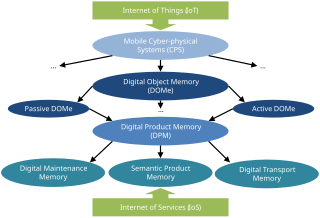Radio-frequency identification (RFID) uses electromagnetic fields to automatically identify and track tags attached to objects. An RFID system consists of a tiny radio transponder, a radio receiver and transmitter. When triggered by an electromagnetic interrogation pulse from a nearby RFID reader device, the tag transmits digital data, usually an identifying inventory number, back to the reader. This number can be used to track inventory goods.

Near-field communication (NFC) is a set of communication protocols that enables communication between two electronic devices over a distance of 4 cm (1.57 in) or less. NFC offers a low-speed connection through a simple setup that can be used to bootstrap more capable wireless connections. Like other "proximity card" technologies, NFC is based on inductive coupling between two antennas present on NFC-enabled devices—for example a smartphone and a printer—communicating in one or both directions, using a frequency of 13.56 MHz in the globally available unlicensed radio frequency ISM band using the ISO/IEC 18000-3 air interface standard at data rates ranging from 106 to 848 kbit/s.

The Electronic Product Code (EPC) is designed as a universal identifier that provides a unique identity for every physical object anywhere in the world, for all time. The EPC structure is defined in the EPCglobal Tag Data Standard, which is a freely available standard. The canonical representation of an EPC is a URI, namely the 'pure-identity URI' representation that is intended for use when referring to a specific physical object in communications about EPCs among information systems and business application software.
QinetiQ is a multinational defence technology company headquartered in Farnborough, Hampshire. It operates primarily in the defence, security and critical national infrastructure markets and run testing and evaluation capabilities for air, land, sea and target systems.
Automatic identification and data capture (AIDC) refers to the methods of automatically identifying objects, collecting data about them, and entering them directly into computer systems, without human involvement. Technologies typically considered as part of AIDC include QR codes, bar codes, radio frequency identification (RFID), biometrics, magnetic stripes, optical character recognition (OCR), smart cards, and voice recognition. AIDC is also commonly referred to as "Automatic Identification", "Auto-ID" and "Automatic Data Capture".

A tracking system, also known as a locating system, is used for the observing of persons or objects on the move and supplying a timely ordered sequence of location data for further processing.

Kevin Ashton is a British technology pioneer who cofounded the Auto-ID Center at the Massachusetts Institute of Technology (MIT), which created a global standard system for RFID and other sensors. He is known for coining the term "the Internet of Things" to describe a system where the Internet is connected to the physical world via ubiquitous sensors.
ODIN provides RFID software for the Aerospace, Government, Healthcare, Financial Services and Social Media markets. ODIN's world headquarters is located in San Diego, CA. ODIN was acquired by Quake Global in December 2012 and continues to focus on healthcare and asset tracking.
The clipped tag is a radio frequency identification (RFID) tag designed to enhance consumer privacy. RFID is an identification technology in which information stored in semiconductor chips contained in RFID tags is communicated by means of radio waves to RFID readers. The most simple passive RFID tags do not have batteries or transmitters. They get their energy from the field of the reader. They transfer their information to the reader by modulating the signal that is reflected back to the reader by the tag. Because tags depend on the reader for power their range is limited, typically up to 10 meters (33 ft) for UHF RFID tags.
Sitronics is a microelectronics company based in Moscow, Russia and controlled by Sistema holding, that also manufactures mobile phones. Its main assets are the electronics fabs, research and development facilities NIIME and Mikron in Zelenograd, and other facilities elsewhere in Eastern Europe.
Deister Electronic is the name generally used to refer to Deister Electronic GmbH Barsinghausen, Germany, and its subsidiaries in North America. Deister Electronic is an industrial enterprise specialised on electronic non-contact identification and security systems founded in 1977. In North America, the companies are Deister Electronics USA, Inc. of Manassas, VA, and Deister Electronics, Inc. of Ontario, Canada.
Real-time locating systems (RTLS), also known as real-time tracking systems, are used to automatically identify and track the location of objects or people in real time, usually within a building or other contained area. Wireless RTLS tags are attached to objects or worn by people, and in most RTLS, fixed reference points receive wireless signals from tags to determine their location. Examples of real-time locating systems include tracking automobiles through an assembly line, locating pallets of merchandise in a warehouse, or finding medical equipment in a hospital.
DASH7 Alliance Protocol (D7A) is an open-source wireless sensor and actuator network protocol, which operates in the 433 MHz, 868 MHz and 915 MHz unlicensed ISM band/SRD band. DASH7 provides multi-year battery life, range of up to 2 km, low latency for connecting with moving things, a very small open-source protocol stack, AES 128-bit shared-key encryption support, and data transfer of up to 167 kbit/s. The DASH7 Alliance Protocol is the name of the technology promoted by the non-profit consortium called the DASH7 Alliance.

Impinj, Inc. is a manufacturer of radio-frequency identification (RFID) devices and software. The company was founded in 2000 and is headquartered in Seattle, Washington. The company was started based on the research done at the California Institute of Technology by Carver Mead and Chris Diorio. Impinj currently produces EPC Class 1, Gen 2 passive UHF RFID chips, RFID readers, RFID reader chips, and RFID antennas, and software applications for encoding chips, and gathering business intelligence on RFID systems.

CYBRA Corporation is a software developer, publisher, and systems integrator in the IBM midrange market. CYBRA provides bar codes, RFID, and RTLS systems for IBM Power Systems and other server lines and other major computing platforms, bar code label and tag printing, and bar code scanning systems.

Founded in 2003, Retail Solutions Inc (RSi) is a software company based in Mountain View, CA that provides software-as-a-service products for data management, reporting and business intelligence, and point of sale applications. RSi was named by Forbes as the biggest SaaS company you've never heard of. The company started out selling radio-frequency identification (RFID) software before moving into its current business. In October 2020, RSi was acquired by IRI Worldwide.

EM Microelectronic, based in Marin, La Tène near Neuchâtel in Switzerland, is a developer and semiconductor manufacturer specialized in the design and production of ultra low power, low voltage integrated circuits for battery-operated and field-powered applications in consumer, automotive and industrial areas. EM Microelectronic SA is a subsidiary of The Swatch Group.

A digital object memory (DOMe) is a digital storage space intended to keep permanently all related information about a concrete physical object instance that is collected during the lifespan of this object and thus forms a basic building block for the Internet of Things (IoT) by connecting digital information with physical objects.
Chipless RFID tags are RFID tags that do not require a microchip in the transponder.
Various schools have been using radio-frequency identification technology to record and monitor students.








